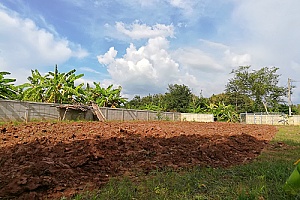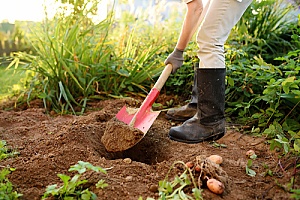 If you have a big job that requires fill dirt to be purchased, it is important to know how much you need, how the dirt is measured, and how many trucks will be needed to deliver it to your location. Even if you have hired a local dirt contractor, being informed will both help them and you so that there are no surprises later in the project. This article will discuss all things fill dirt — including how much a cubic foot of dirt weighs — so that you can understand how much fill dirt you need for your project.
If you have a big job that requires fill dirt to be purchased, it is important to know how much you need, how the dirt is measured, and how many trucks will be needed to deliver it to your location. Even if you have hired a local dirt contractor, being informed will both help them and you so that there are no surprises later in the project. This article will discuss all things fill dirt — including how much a cubic foot of dirt weighs — so that you can understand how much fill dirt you need for your project.
What is Fill Dirt and What is It Used For?
Fill dirt is just what the name indicates: dirt that fills. It is also known as a subsoil (substrata) that sometimes contains clay, sand, and various other materials, including a little bit of topsoil. Fill dirt is a common substance used in construction or yard work. Any time a hole or a depression has been made in the ground, it needs to be filled. This is where fill dirt comes in.
The most common use for fill dirt is for landscaping purposes. Depressions and sinkholes in the yard need to be filled to provide safe and even footing. If an inground pool has been removed, the leftover hole also needs to be filled with mostly fill dirt, and then topsoil on the top layer so grass can grow. Other landscaping jobs that require fill dirt, either as a solid foundation or to alter the landscape, are patios, ponds, waterfalls, or gazebos. Highway maintenance also uses a lot of fill dirt to keep the sides of the road from eroding or providing a place for drivers to pull off the road and park.
Previously I mentioned topsoil. It is important to be aware that fill dirt and topsoil are two entirely different types of dirt. Topsoil is chock full of organic materials and microorganisms. This makes the soil rich and fertile, allowing grass, trees, and gardens to grow well. Fill dirt, in contrast, contains none of that stuff. Since it is not made up of organic material, there is no risk of it decomposing and causing further issues in the ground. This makes fill dirt the perfect solution to provide stable foundations for yards and outdoor structures.
What is a Cubic Foot of Dirt?
 A cubic foot of dirt is the amount of dirt that you need to fill a cubic foot of empty space. Dirt is often sold in cubic feet or yards because it is impossible to weigh the empty space you need to be filled. So, instead of going by weight, dirt contractors go by volume. When you speak to your fill dirt contractor, they will ask you how much you need, again in either cubic feet or cubic yards. It is important that you know this information so you can avoid ending up with too much or too little dirt.
A cubic foot of dirt is the amount of dirt that you need to fill a cubic foot of empty space. Dirt is often sold in cubic feet or yards because it is impossible to weigh the empty space you need to be filled. So, instead of going by weight, dirt contractors go by volume. When you speak to your fill dirt contractor, they will ask you how much you need, again in either cubic feet or cubic yards. It is important that you know this information so you can avoid ending up with too much or too little dirt.
How Much Does It Weigh?
It is also important to know how much the dirt you need weights, in addition to the volume you need. That is because your contractor is likely only dumping it for you. You are still the one that will have to move it from where it is dumped to where it needs to be filled. If your job requires a lot of dirt, it is also going to require a lot of physical work on your part, no matter where it gets dumped, and the best way to determine how much labor you’ll need to expend is to determine the weight of the dirt you’re moving.
To first determine how much a cubic foot weighs, you start with how much a cubic yard weighs, which is 2,000lbs (or 1 ton). Next, you need to do a little bit of math. There are 27 cubic feet in a cubic yard, so if you divide 2000 by 27, that comes out to 74.07lbs (0.037 tons).
No matter how many cubic feet of fill dirt you need, it is going to weigh a lot. We recommend investing in a good wheelbarrow. Also, when the truck comes to deliver your dirt, have them drop it as close as possible to the area you need to fill. The less walking you have to do from the dirt pile to the hole, the better.
How Many Cubic Feet of Dirt Can a Dump Truck Haul?
A standard truck can hold roughly 10 to 12 cubic yards of fill dirt, which equals to about 270 to 324 cubic feet, which comes out to 20,000 to 24,000 lbs of dirt. Some fill dirt contractors require a minimum order of fill dirt, so if you only need a small amount for one project, it may be best to wait until you have other projects needing fill dirt.
Alternatively, if you need the dirt now, and you know there will be extra, consider finding a way to store the extra dirt where it will stay dry. You can also start looking for trouble spots in your yard that need filling, plan another project as well, or share your leftover fill dirt with a neighbor. Whatever you do, you will want to get as much use out of one truckload as possible.
How Many Trucks Of Fill Dirt Do I Need?
 To find out how much dirt you need, you will first need to do some measurements, and then a bit more math. It will all depend on the shape of your space. For rectangles and squares, you must measure the length, width, and height of the space in feet (not inches), then multiply them together to get the cubic feet.
To find out how much dirt you need, you will first need to do some measurements, and then a bit more math. It will all depend on the shape of your space. For rectangles and squares, you must measure the length, width, and height of the space in feet (not inches), then multiply them together to get the cubic feet.
If the space is circular, first measure the diameter, then divide by 2 to get the radius. Multiply the radius by itself (so if the diameter is 10ft, the radius would be 5ft, and the radius multiplied by itself would be 25ft), and then multiply that number by 3.14 (pi). Multiply your result with the height, and now you will have the cubic feet you need.
Speak With A Fill Dirt Contractor For More Information
Be sure to do these calculations multiple times to avoid any errors. If you run into any issues with your calculations, or you have further questions about ordering fill dirt, please contact Dirt Connections in Fairfax, VA for help. Additionally, you can use the Dirt Connections Portal using the button below to see the μterials available to you.








































